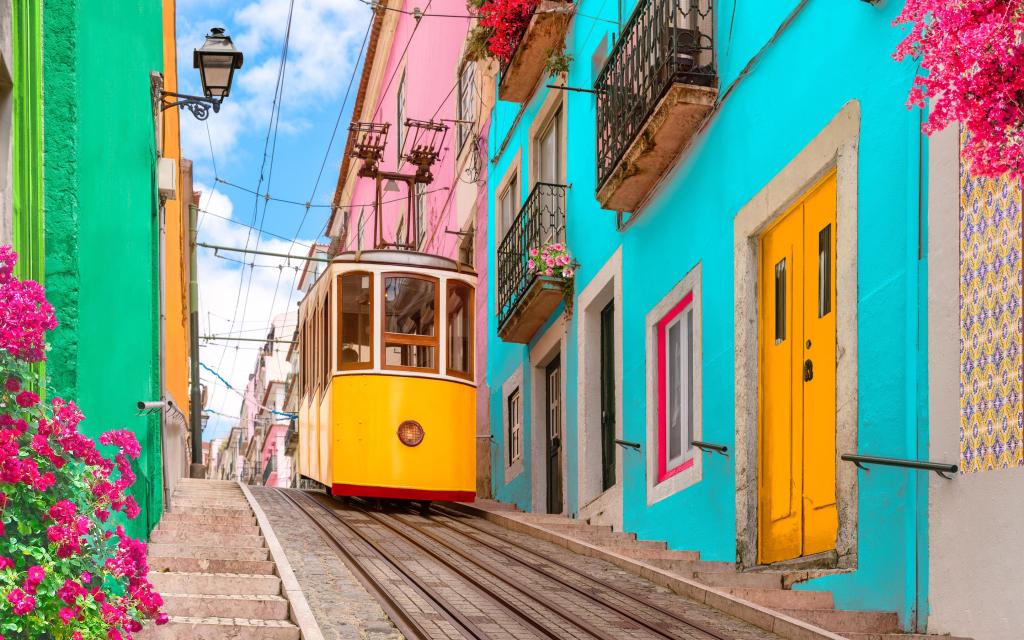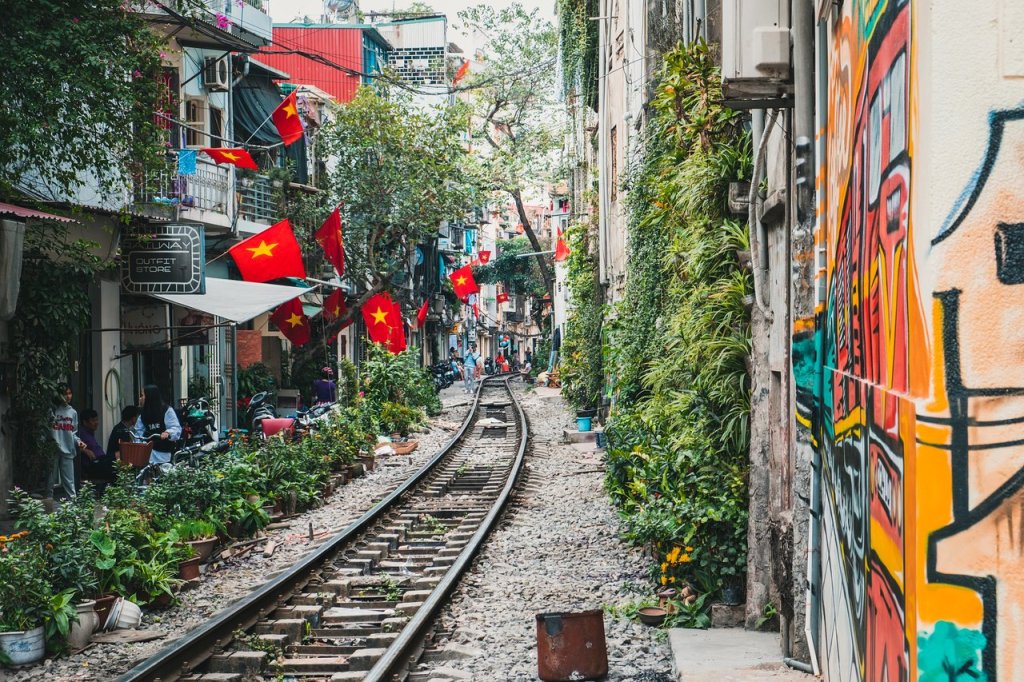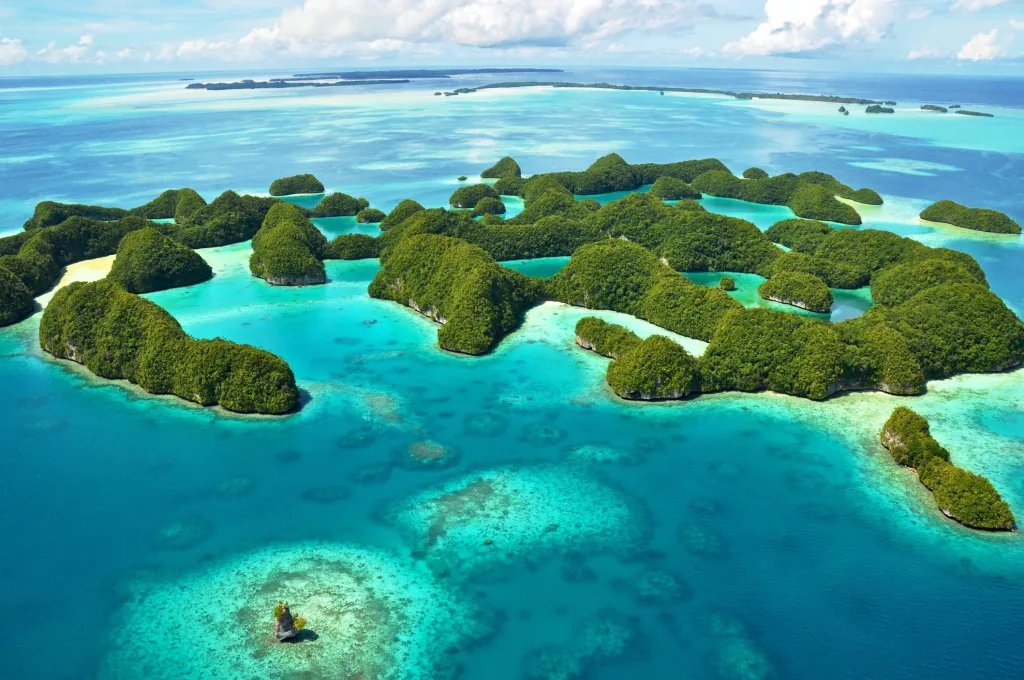
Nestled within the rugged Andes Mountains of Peru, Machu Picchu is an ancient Incan citadel perched at an altitude of approximately 2,430 meters (7,970 feet) above sea level. This remarkable archaeological site is situated in the Cusco Region and is shrouded in lush, emerald-green cloud forest.
Machu Picchu, often referred to as the “Lost City of the Incas,” is renowned for its awe-inspiring beauty and enigmatic history. Its location amidst breathtaking natural surroundings offers visitors a journey back in time, providing a glimpse into the advanced engineering and architectural prowess of the Inca civilization.
As you approach this iconic site, you’ll be greeted by the awe-inspiring sight of stone terraces, temples, and structures seamlessly integrated into the verdant landscape. The Huayna Picchu and Machu Picchu mountains stand sentinel, adding to the mystical allure of this remarkable citadel.
Machu Picchu’s remote and lofty location adds to its enigma, as it remained hidden from the Spanish conquistadors during the colonial era. It was only in 1911 that American historian and explorer Hiram Bingham brought this extraordinary archaeological site to international attention.
Today, Machu Picchu is celebrated not only for its historical significance but also for its mesmerizing beauty. Its inclusion on countless travelers’ bucket lists is a testament to the enduring fascination it holds for people from all corners of the globe.
When to Visit:
The best time to visit Machu Picchu is during the dry season, which spans from May to October. During these months, you can expect clear skies and minimal rainfall, making for ideal trekking conditions along the Inca Trail and comfortable exploration of the citadel.
Budget-conscious travelers may consider visiting during the shoulder months of April and November, where the weather is still favorable, but there are fewer crowds. The rainy season, from December to March, should be approached with caution, as heavy rain can lead to trail closures and slippery conditions.
Budget and Costs:
Traveling to Machu Picchu offers options for various budgets. Here’s a breakdown of the key expenses to consider:
- Entrance Fees: The cost of admission to Machu Picchu varies depending on your nationality and whether you choose to include additional attractions such as Huayna Picchu or Machu Picchu Mountain. Expect to pay around $30 to $70 for entrance.
- Transportation: Transportation costs encompass flights to Cusco, train tickets to Aguas Calientes (the gateway to Machu Picchu), and bus tickets to the citadel. Budget for approximately $300 to $500 for these expenses, depending on your location and preferences.
- Accommodation: Accommodation in Aguas Calientes ranges from budget hostels to luxury hotels. Budget travelers can find options for around $20 to $50 per night, while upscale accommodations may exceed $300 per night.
- Food: Dining costs can vary greatly. Local eateries offer affordable meals, while upscale restaurants cater to more refined tastes. Plan to spend around $10 to $30 per meal.
- Guided Tours: The cost of guided tours varies, but it’s a valuable investment for a richer understanding of Machu Picchu’s history and significance. Expect to pay approximately $50 to $100 for guided tours.
Overall, a moderate budget for a Machu Picchu trip, including trekking the Inca Trail, can range from $800 to $1,500 per person for a multi-day adventure.
Accommodation Options:
Aguas Calientes, also known as Machu Picchu Pueblo, serves as the primary base for visitors exploring Machu Picchu. Here, you’ll find a range of accommodation options to suit different budgets and preferences:
- Budget Hostels: Perfect for backpackers and budget-conscious travelers, hostels offer affordable dormitory-style or private rooms. Prices typically range from $20 to $50 per night.
- Mid-Range Hotels: Mid-range hotels in Aguas Calientes offer comfortable rooms with modern amenities. Prices range from $60 to $150 per night.
- Luxury Hotels: For those seeking indulgence, luxury hotels provide lavish accommodations, gourmet dining, and spa services. Expect prices starting from $200 per night and reaching upwards of $500 per night.
- Eco-Lodges: Some eco-friendly lodges in the nearby cloud forest offer a unique and sustainable stay experience. Prices vary depending on the lodge’s amenities and location.
- Camping: If you’re trekking the Inca Trail, camping is an integral part of the experience. Trek operators provide camping gear and support services.
Selecting the right accommodation depends on your travel style and budget. Regardless of where you stay, book in advance, especially during the peak tourist season.

How to Get There:
Reaching Machu Picchu involves a multi-step journey, beginning with your arrival in Peru. Here’s an overview of the key transportation options:
- Fly to Lima, Peru: International travelers typically arrive in Lima, Peru’s capital. From Lima, you can book a domestic flight to Alejandro Velasco Astete International Airport in Cusco.
- Cusco to Aguas Calientes: From Cusco, the gateway to Machu Picchu, you have two primary options for reaching Aguas Calientes, the town closest to the citadel:
- Train: Board a scenic train ride from Cusco or Ollantaytambo to Aguas Calientes. The journey offers breathtaking vistas of the Sacred Valley. Be sure to book train tickets in advance, and choose from various service levels, including luxury options like the Hiram Bingham train.
- Inca Trail: If you’re up for a trekking adventure, consider hiking the Inca Trail, a multi-day journey that culminates at Machu Picchu. This option requires a permit and advanced booking through a licensed tour operator.
- Aguas Calientes to Machu Picchu: From Aguas Calientes, take a short bus ride or embark on a challenging hike to the entrance of Machu Picchu.
Navigating the transportation logistics requires careful planning and coordination. Ensure you have all necessary reservations, permits, and tickets well in advance of your trip.
Travel Itineraries:
Crafting a well-rounded travel itinerary allows you to make the most of your Machu Picchu adventure. Here are two sample itineraries for different types of travelers:
1. Classic Machu Picchu Experience (4 Days):
- Day 1: Arrival in Cusco, acclimatization, and exploring the city’s historic center.
- Day 2: Sacred Valley exploration, visiting Pisac Market and Ollantaytambo.
- Day 3: Begin the Inca Trail trek, camping at Wayllabamba or Llulluchapampa.
- Day 4: Inca Trail hike to Machu Picchu, guided tour, and return to Cusco.
2. Relaxed Discovery (3 Days):
- Day 1: Arrival in Cusco, leisurely exploration of the city’s landmarks.
- Day 2: Travel to Aguas Calientes by train, afternoon relaxation, and hot springs visit.
- Day 3: Early morning visit to Machu Picchu, guided tour, and return to Cusco.
These itineraries provide a starting point, but you can customize your journey based on your interests, fitness level, and available time.
List of Things to Know Before Going:
Before embarking on your Machu Picchu adventure, consider the following important tips:
- Acclimatize to Altitude: Cusco is at high altitude, so spend a day acclimatizing before trekking or visiting Machu Picchu.
- Permits and Tickets: Ensure you have all required permits, tickets, and reservations well in advance.
- Inca Trail Reservations: If hiking the Inca Trail, book with a licensed tour operator and secure your permit early.
- Weather Variability: Prepare for changing weather conditions by packing layers and rain gear.
- Footwear: Choose comfortable, sturdy hiking boots with good traction for exploring Machu Picchu.
- Guided Tours: Consider joining a guided tour for a more enriching experience and historical insights.
- Pack Light: Keep your daypack minimal for ease of exploration within Machu Picchu.
- Altitude Sickness: Be aware of symptoms and take preventive measures. Stay hydrated and avoid overexertion.
- Responsible Travel: Respect the rules and regulations of Machu Picchu, including not touching or climbing on the ruins.
- Preservation: Help protect the site by disposing of waste properly and not removing any artifacts.’
Top 10 Things to Do:
Machu Picchu offers an array of captivating experiences. Here are the top 10 things to do during your visit:
- Explore the Citadel: Wander through the awe-inspiring ruins, including the Temple of the Sun, Intihuatana stone, and more.
- Hike Huayna Picchu or Machu Picchu Mountain: Enjoy panoramic views of the citadel and surrounding landscape from these peaks.
- Watch the Sunrise: Witness the ethereal beauty of the sunrise over Machu Picchu from strategic viewpoints.
- Visit the Sun Gate: Take a hike to the Inti Punku, the Sun Gate, for a breathtaking view of the citadel.
- Explore the Inca Bridge: Discover the Inca Bridge, an ancient access route with a unique stone structure.
- Museum and Casa Concha: Learn about the history of Machu Picchu at the onsite museum.
- Photography: Capture the beauty of Machu Picchu from various angles and perspectives.
- Hot Springs: Relax in the natural hot springs of Aguas Calientes after a day of exploration.
- Birdwatching: Spot a variety of bird species, including the Andean cock-of-the-rock and the Andean condor.
- Cultural Experiences: Interact with local Quechua-speaking communities and learn about their customs.
Local Cuisine:
Peruvian cuisine is celebrated worldwide for its diversity and flavors. While in the region, savor these traditional dishes:
- Ceviche: Fresh fish or seafood marinated in lime juice, garnished with onions and cilantro.
- Lomo Saltado: A stir-fry of beef, onions, tomatoes, and French fries, often served with rice.
- Anticuchos: Grilled skewers of marinated beef heart or other meats, typically served with potatoes.
- Papa a la Huancaina: Sliced potatoes smothered in a creamy, spicy cheese sauce.
- Aji de Gallina: A creamy chicken stew with a mildly spicy yellow chili sauce.
- Quinoa: A high-protein grain, often served in salads or as a side dish.
- Chicha Morada: A refreshing drink made from purple corn, boiled with fruit and spices.
- Pisco Sour: Peru’s national cocktail, made with pisco (grape brandy), lime juice, syrup, and egg white.
- Alpaca: Taste this lean and tender meat, often served as steaks or in stews.
- Empanadas: Delicious pastry pockets filled with various ingredients like cheese, meat, or vegetables.
Don’t miss the opportunity to dine at local restaurants and savor the authentic flavors of Peru during your Machu Picchu journey.
Culture:
The cultural tapestry of Machu Picchu is woven from the threads of the Inca civilization, colonial influences, and modern Peruvian traditions. While exploring the citadel and its surroundings, you’ll encounter remnants of the Inca Empire, including intricate stone masonry and sacred temples.
The local Quechua-speaking communities continue to preserve their rich cultural heritage, and you may have the chance to engage with them during your visit. From colorful festivals to traditional textiles, the spirit of the Andes infuses every corner of this region.
As you traverse Machu Picchu, take a moment to reflect on the spiritual significance this site held for the Inca people. The alignment of structures with astronomical events and the reverence for nature and the elements reveal a deep spiritual connection.

Hidden Gem:
While Machu Picchu itself is the most renowned attraction, don’t overlook the charm of the nearby town of Aguas Calientes. This quaint village offers its own set of attractions, including natural hot springs, vibrant markets, and a relaxed atmosphere.
After a day of exploration, soak in the soothing thermal waters of the hot springs, a perfect way to unwind and rejuvenate. Aguas Calientes also boasts a lively artisan market where you can find unique souvenirs, textiles, and handicrafts.
Additionally, the Manuel Chávez Ballón Site Museum in Aguas Calientes provides valuable insights into the history and discovery of Machu Picchu. Explore its exhibits to gain a deeper appreciation of the archaeological significance of the region.
Local Festivals and Events:
To immerse yourself in the local culture, time your visit to coincide with one of the region’s colorful festivals or events. Here are a few noteworthy celebrations:
- Inti Raymi: Held on June 24th in Cusco, this festival pays homage to the Inca sun god, Inti, with colorful processions, music, and dance.
- Cusco Carnival: Occurring in February or March, this lively carnival features parades, water fights, and traditional dances.
- Paucartambo Festival: Taking place in July in the town of Paucartambo, this festival includes vibrant masks, music, and dances.
- Virgen de la Candelaria: Celebrated in Puno in February, this festival showcases traditional Andean dances, elaborate costumes, and religious processions.
- Corpus Christi: Observed in Cusco in June, this religious celebration features a grand procession of saints and traditional dishes.
- Fiestas Patrias: Peru’s Independence Day on July 28th and 29th is marked by patriotic parades, music, and fireworks.
Participating in these festivities allows you to witness the vibrant traditions and cultural heritage of the Andean people.
Photography Tips:
Capturing the beauty of Machu Picchu is a rewarding endeavor. Here are some photography tips to help you make the most of your visit:
- Golden Hours: Plan your visit during the early morning or late afternoon for the best natural lighting and softer shadows.
- Wide-Angle Lens: Use a wide-angle lens to capture the expansive views and intricate architecture of Machu Picchu.
- Rule of Thirds: Compose your shots using the rule of thirds to create balanced and visually appealing photographs.
- Include People: To convey a sense of scale, include people in your photos to showcase the grandeur of the citadel.
- Details Matter: Don’t forget to capture close-up shots of intricate stonework, carvings, and unique angles.
- Sunrise and Sunset: Consider capturing the sunrise or sunset over Machu Picchu for ethereal lighting and colors.
- Huayna Picchu: Hike to Huayna Picchu for stunning panoramic shots of Machu Picchu from above.
- Weather Preparation: Be ready for changing weather conditions by protecting your camera equipment with weather-resistant gear.
- Tripod: If you plan to shoot in low light conditions, bring a tripod to ensure stability.
- Patience: Wait for the right moment to capture that perfect shot and embrace the tranquility of the surroundings.
Remember to respect the rules and guidelines for photography at Machu Picchu, which include not touching or climbing on the ruins.
Day Trips:
While Machu Picchu is undoubtedly the main attraction, the region offers several rewarding day trips and excursions:
- Machu Picchu Mountain: Hike to the summit of Machu Picchu Mountain for breathtaking panoramic views of the citadel.
- Huayna Picchu: Embark on a challenging hike to Huayna Picchu for a unique perspective of Machu Picchu.
- Mandor Waterfall: Take a scenic walk to Mandor Waterfall, a tranquil oasis nestled in the cloud forest.
- Ollantaytambo: Explore the charming town of Ollantaytambo, known for its well-preserved Inca architecture and archaeological sites.
- Pisac: Visit the Pisac Archaeological Park and market to discover Inca ruins and vibrant local culture.
- Moray and Maras: Discover the ancient agricultural terraces of Moray and the surreal salt flats of Maras.
- Sacred Valley: Embark on a day tour of the Sacred Valley, visiting multiple historical sites and communities.
These day trips offer diverse experiences that complement your Machu Picchu adventure and provide a deeper understanding of the region’s history and culture.
Family-Friendly Activities:
Traveling with family to Machu Picchu is a fantastic way to introduce children to history and adventure. Consider these family-friendly activities:
- Train Ride: Kids will enjoy the scenic train journey to Aguas Calientes, complete with panoramic windows.
- Guided Tour: Opt for a family-friendly guided tour to make history come alive for children.
- Nature Walks: Explore the lush cloud forest surrounding Machu Picchu and look for wildlife and unique flora.
- Llama and Alpaca Encounters: Kids can meet these friendly animals in the area and take memorable photos.
- Hot Springs: A visit to the hot springs in Aguas Calientes is a relaxing family activity.
- Interactive Museums: Explore interactive museums in Aguas Calientes for an educational experience.
- Photography Quest: Engage children in a photography quest to capture their unique perspectives of Machu Picchu.
Machu Picchu’s mystical allure and opportunities for adventure make it a memorable destination for families.
Language and Local Phrases:
While Spanish is the official language in Peru, especially in urban areas, you’ll find Quechua spoken in many rural communities. Here are some basic Spanish phrases to help you communicate during your visit:
- Hello: Hola (oh-la)
- Please: Por favor (por fah-vor)
- Thank you: Gracias (gra-see-as)
- Yes: Sí (see)
- No: No (noh)
- Excuse me: Perdón/disculpe (pair-don/dees-kool-peh)
- How much is this?: ¿Cuánto cuesta esto? (kwahn-toh kwes-tah es-toh)
- I need help: Necesito ayuda (neh-say-see-toh ah-oo-dah)
- Restroom: Baño (bah-nyoh)
Learning a few basic phrases can enhance your interactions with locals and enrich your cultural experience.
Local Artisan Workshops:
The region around Machu Picchu is renowned for its artisanal craftsmanship. Explore these workshops to discover handmade treasures:
- Textiles: Visit local weavers who create vibrant textiles using traditional techniques.
- Pottery: Explore pottery workshops where artisans craft intricate ceramics and pottery.
- Silver Jewelry: Find intricate silver jewelry made by skilled artisans in the Sacred Valley.
- Woodwork: Discover intricate woodcarvings and sculptures crafted by talented woodworkers.
- Marketplaces: Browse local markets for a wide range of artisanal products, from clothing to ceramics.
Supporting local artisans by purchasing their handmade goods allows you to take a piece of the Andes home with you.
Must-Pack Items:
To ensure a smooth and enjoyable journey to Machu Picchu, don’t forget to pack these essential items:
- Passport and Travel Documents: Carry a copy of your passport and relevant travel documents.
- Permits and Tickets: Ensure you have all required permits, train tickets, and entrance tickets.
- Daypack: A comfortable daypack for essentials like water, snacks, and a light jacket.
- Comfortable Footwear: Sturdy and comfortable hiking boots or walking shoes with good traction.
- Weather-Appropriate Clothing: Layers for varying temperatures and rain gear for unexpected showers.
- Sun Protection: Sunscreen, sunglasses, and a wide-brimmed hat to shield from the high-altitude sun.
- Insect Repellent: Especially if you plan to explore the cloud forest around Machu Picchu.
- Reusable Water Bottle: Stay hydrated by refilling your bottle from purified water stations.
- Camera and Accessories: Capture the beauty of Machu Picchu with your camera and spare batteries.
- First Aid Kit: Basic essentials like band-aids, pain relievers, and altitude sickness medication.
- Travel Adapter: Peru uses Type A and Type B electrical outlets.
- Cash: While there are ATMs in Aguas Calientes, it’s wise to carry some cash in local currency (Peruvian Sol) for small purchases.
- Snacks: Energy bars, nuts, and snacks for sustenance during your explorations.
- Travel Insurance: Ensure you have comprehensive travel insurance covering health, trip cancellations, and emergencies.
- Maps and Guidebooks: Maps of Machu Picchu and guidebooks for reference.
Packing thoughtfully will enhance your comfort and enjoyment during your Machu Picchu adventure.
5 Travel Tips:
- Plan Ahead: Book accommodations, permits, and train tickets well in advance to secure your preferred options.
- Stay Hydrated: The high altitude can lead to dehydration. Drink plenty of water and avoid excessive alcohol consumption.
- Respect the Environment: Follow Leave No Trace principles by disposing of waste properly and respecting the natural and cultural heritage of the region.
- Altitude Awareness: Be mindful of altitude sickness symptoms, and take it easy during your first days at high elevation.
- Local Cuisine: Embrace the opportunity to savor authentic Peruvian dishes and be open to trying local specialties.
Shopping and Where to Find It:
Aguas Calientes offers a range of shopping opportunities, including:
- Artisan Markets: Visit the local markets in Aguas Calientes for textiles, handicrafts, and souvenirs.
- Aguas Calientes Market: This bustling market is a treasure trove of Peruvian goods, including alpaca wool products, ceramics, and jewelry.
- Manuel Chávez Ballón Site Museum: Find a selection of books, postcards, and educational materials related to Machu Picchu.
- Local Workshops: Some local artisans sell their creations directly from their workshops.
- Boutique Stores: Upscale boutiques in Aguas Calientes offer high-quality textiles and jewelry.
When shopping, remember to practice your negotiation skills, as bargaining is common in local markets.
Nightlife and Where to Go:
While Machu Picchu is a destination known for its cultural and historical significance, Aguas Calientes offers a modest nightlife scene with a few bars and restaurants where you can unwind. Some popular options include:
- Indio Feliz: A cozy restaurant with an inviting atmosphere and a selection of cocktails.
- Toto’s House: A bar known for its lively music, where you can enjoy a drink or dance.
- Machu Pizza: A pizzeria with an assortment of pizzas and drinks.
- Aguas Calientes Hot Springs: The local hot springs are open into the evening, allowing for a relaxing soak under the starry sky.
- Enjoy the Local Cuisine: Savor local Peruvian dishes and drinks at various restaurants in Aguas Calientes.
While the nightlife in Aguas Calientes is relatively subdued compared to larger cities, it provides a pleasant way to unwind after a day of exploration.
Visa and Travel Documents:
Before traveling to Peru, ensure you have the following visa and travel documents in order:
- Passport: Ensure your passport is valid for at least six months beyond your intended departure date from Peru.
- Tourist Visa: Depending on your nationality, you may not require a visa for short visits as a tourist. Check the visa requirements for Peru based on your citizenship.
- Tourist Card: You’ll receive a tourist card upon arrival in Peru, which you must keep with you throughout your stay.
- Machu Picchu Entrance Tickets: Secure your entrance tickets to Machu Picchu in advance.
- Inca Trail Permits: If you plan to hike the Inca Trail, ensure you have the necessary permits, typically obtained through a licensed tour operator.
- Train Tickets: If you’re taking the train to Aguas Calientes, book your train tickets ahead of time.
- Flight Tickets: If your journey includes domestic flights within Peru, keep your flight tickets handy.
- Travel Insurance: Consider travel insurance that covers potential trip cancellations, medical emergencies, and unforeseen events.
- Vaccination Records: Check if any vaccinations or health precautions are recommended or required for your trip.
- Itinerary and Reservations: Have copies of your itinerary, hotel reservations, and relevant contact information.
By ensuring your travel documents are in order, you’ll have a smooth and worry-free journey to Machu Picchu.
Safety and Health Information:
Machu Picchu is a safe destination for travelers, but it’s essential to take precautions:
- Altitude Sickness: Be aware of the symptoms of altitude sickness (soroche) and acclimatize accordingly.
- Water: Drink bottled water or use a water purifier to avoid waterborne illnesses.
- Sun Protection: Protect yourself from the sun’s intense rays by wearing sunscreen, sunglasses, and a hat.
- Hiking Safety: If you’re hiking, stay on designated trails, follow your guide’s instructions, and take breaks to prevent exhaustion.
- Insect Repellent: Apply insect repellent, especially if you plan to explore the cloud forest.
- Emergency Numbers: Familiarize yourself with local emergency numbers and the location of medical facilities.
- Travel Insurance: Consider purchasing travel insurance that covers health emergencies and medical evacuations.
Remember that Machu Picchu is located in a remote area, so it’s essential to be prepared for any unexpected situations. Travel with a first aid kit and any necessary medications.
Conclusion:
Your journey to Machu Picchu promises to be a transformative experience, filled with wonder, history, and adventure. As you explore the Lost City of the Incas, take the time to immerse yourself in the rich culture and stunning landscapes that surround this extraordinary archaeological marvel.
From the awe-inspiring ruins of Machu Picchu to the vibrant markets of Aguas Calientes, the region offers a tapestry of experiences that will leave an indelible mark on your traveler’s soul. Whether you choose to hike the Inca Trail or savor the view from Huayna Picchu, Machu Picchu’s magic will forever hold a place in your heart.
So, pack your bags, prepare your camera, and get ready to embark on an unforgettable journey to the heart of the Andes. Machu Picchu awaits, ready to unveil its mysteries to the intrepid traveler in you.





Leave a comment